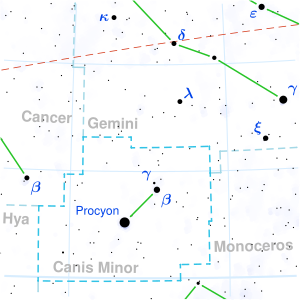Location of Luyten's Star in the constellation Canis Minor | |
| Observation data Epoch J2000 Equinox J2000 | |
|---|---|
| Constellation | Canis Minor |
| Right ascension | 07h 27m 24.49897s[1] |
| Declination | +05° 13′ 32.8415″[1] |
| Apparent magnitude (V) | 9.872[2] |
| Characteristics | |
| Spectral type | M3.5V[3] |
| U−B color index | 1.115[2] |
| B−V color index | 1.571[2] |
| Variable type | None |
| Astrometry | |
| Radial velocity (Rv) | 17.35±0.19[1] km/s |
| Proper motion (μ) | RA: 571.232 mas/yr[1] Dec.: −3,691.487 mas/yr[1] |
| Parallax (π) | 264.1269 ± 0.0413 mas[1] |
| Distance | 12.348 ± 0.002 ly (3.7861 ± 0.0006 pc) |
| Absolute magnitude (MV) | 11.94[2] |
| Details[4] | |
| Mass | 0.29 M☉ |
| Radius | 0.293±0.027 R☉ |
| Luminosity | 0.0088 L☉ |
| Surface gravity (log g) | 5[5] cgs |
| Temperature | 3,382±49 K |
| Metallicity [Fe/H] | 0.09±0.17 dex |
| Rotation | 115.6±19.4 d,[6] ~99 d[4] |
| Age | ≳8 Gyr |
| Other designations | |
| Database references | |
| SIMBAD | data |
Luyten's Star /ˈlaɪtənz/[citation needed] (GJ 273) is a red dwarf in the constellation Canis Minor located at a distance of 12.35 light-years (3.79 parsecs) from the Sun. It has a visual magnitude of 9.9, making it too faint to be viewed with the unaided eye. It is named after Willem Jacob Luyten, who, in collaboration with Edwin G. Ebbighausen, first determined its high proper motion in 1935.[8] The star has two confirmed planets and two candidate planets,[4] of which Luyten b is in the circumstellar habitable zone.[9]
- ^ a b c d e Cite error: The named reference
GaiaDR3was invoked but never defined (see the help page). - ^ a b c d Cite error: The named reference
mnras334was invoked but never defined (see the help page). - ^ Cite error: The named reference
RECONSwas invoked but never defined (see the help page). - ^ a b c Cite error: The named reference
PozuelosSuárez2020was invoked but never defined (see the help page). - ^ Cite error: The named reference
mnras388was invoked but never defined (see the help page). - ^ Cite error: The named reference
mnras452_3_2745was invoked but never defined (see the help page). - ^ "BD+05 1668". SIMBAD. Centre de données astronomiques de Strasbourg. Retrieved 29 October 2023.
- ^ Cite error: The named reference
hcob900_1was invoked but never defined (see the help page). - ^ Cite error: The named reference
Astudillo-Defru2017was invoked but never defined (see the help page).
